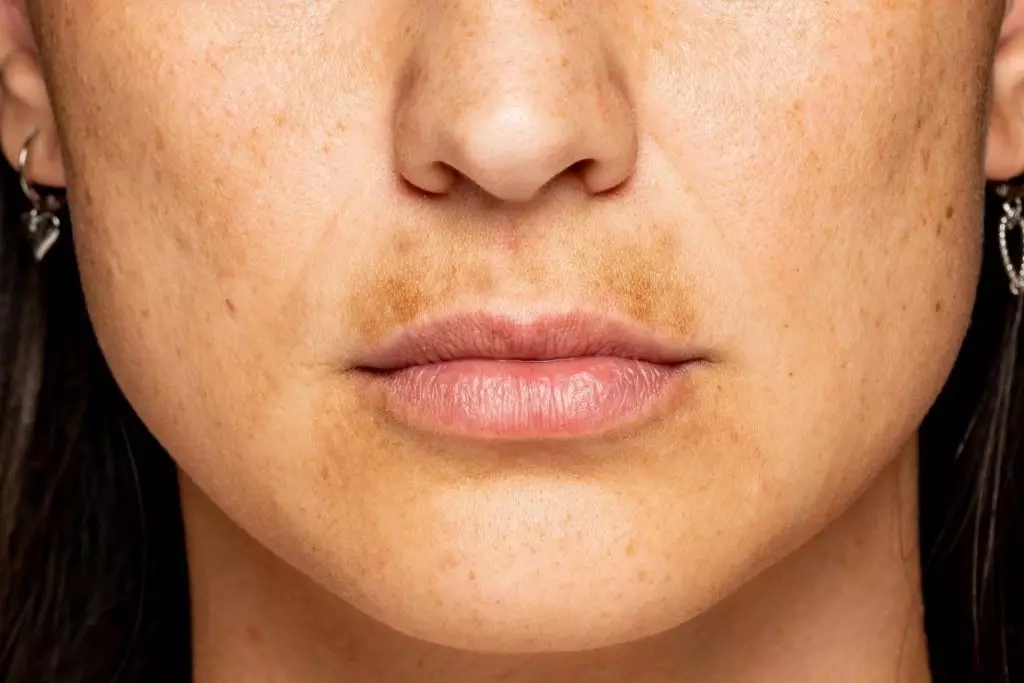Pregnancy mask, also known as chloasma or melasma, is a form of hyperpigmentation that affects between 50 and 70% of pregnant women. These dark spots generally appear on the face, particularly on the forehead, cheeks and around the mouth. Let’s find out everything there is to know about this phenomenon so that we can better understand it and possibly prevent it.
What is a pregnancy mask?
Pregnancy mask is the appearance of irregular dark spots on the skin of the face. This form ofhyperpigmentation develops mainly in women during pregnancy, but can also affect some men and even non-pregnant women. The main characteristic of these spots is that they are asymptomatic, although they can alter the aesthetic appearance of those who suffer from them.
Hormonal origins
Hormones produced during pregnancy, such as oestrogen and progesterone, play a crucial role in the development of pregnancy mask. These hormones stimulate excessive production of melanin – the pigment responsible for skin colour – leading to hyperpigmentation. Areas exposed to the sun are particularly vulnerable to this phenomenon.
Environmental factors
In addition to hormonal changes, certain environmental factors exacerbate this type of blemish. Exposure to the sun ‘s UV rays is one of the main triggers of pregnancy mask. The sun intensifies melanin production, making existing spots worse. The use of sun protection is therefore imperative for any pregnant woman at risk of developing this condition.
How can pregnancy mask be prevented?
Preventing the development of these brown spots can be complex. However, there are several strategies to minimise their appearance on the face.
Use of sun cream
Regular application of a sun cream with a high SPF is one of the most effective methods of combating pregnancy mask. Opt for broad-spectrum UVA and UVB protection and reapply every two hours, especially during outdoor activities.
Avoid irritating agents
Avoiding cosmetics and skincare products containing irritants such as perfumes and certain preservatives can also reduce the risk ofhyperpigmentation. Prefer gentle formulations specially designed for sensitive skin.
- Choose gentle alcohol-free cleansers
- Choose mineral rather than chemical sunscreens
- Use moisturisers adapted to sensitive skin
Treatments available to reduce the mask of pregnancy
While it is not possible to completely prevent the appearance of a pregnancy mask, there are various ways of reducing its appearance. Here are some commonly recommended treatment options:
Depigmenting creams
Creams containing active ingredients such as hydroquinone, kojic acid or even vitamin C can help lighten spots and even out skin tone. Use them under the supervision of a dermatologist to avoid possible skin complications.
Laser treatments and chemical peels
For more severe cases, specialised treatments such as fractional laser or chemical peels may be considered. However, these procedures should only be carried out after pregnancy and when breast-feeding, as they involve invasive techniques requiring extra caution.
Natural remedies
Some natural solutions, such as using lemon juice, known for its skin-lightening properties, or turmeric-based masks, can offer gentler, more natural alternatives for reducing spots.
Psychological and social impact of the pregnancy mask
Pregnancy masks can sometimes have a negative impact on the emotional and social state of the individuals concerned. Understanding this impact is essential if we are to offer appropriate solutions, not only physically but also psychologically.
Self-esteem
The presence of visible spots on the face can affect the self-esteem of pregnant women. They may feel embarrassed or ashamed, affecting their day-to-day social interactions. Emotional support and psychological counselling can play a major role in improving their overall well-being.
Social perception
Although the pregnancy mask is purely cosmetic, the social perception of spots can lead to inappropriate judgements or comments being made about the women concerned. Informing those around you and raising awareness of the realities of this phenomenon can go a long way towards reducing stigmatisation.
The long-term impact of the pregnancy mask on the skin
Although often temporary, the pregnancy mask can leave lasting marks if not treated correctly. Let’s take a look at its longer-term impact and the possibilities for ongoing management.
Residual pigmentation
After pregnancy, some spots may fade naturally while others persist for a long time. An appropriate skincare routine, including regular sessions with a dermatologist, can help to gradually improve these spots.
Skin sensitivity
Once affected by significant hyperpigmentation, the skin tends to remain sensitive to future exposure. An ongoing commitment to sun protection and the use of moisturisers is recommended to preserve long-term skin health.


